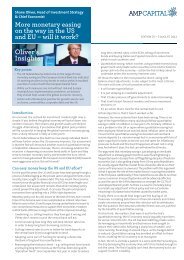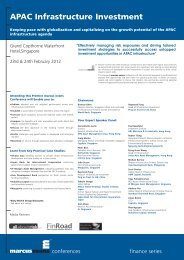AMP Capital Investors Limited
AMP Capital Investors Limited
AMP Capital Investors Limited
Create successful ePaper yourself
Turn your PDF publications into a flip-book with our unique Google optimized e-Paper software.
<strong>AMP</strong> <strong>Capital</strong> <strong>Investors</strong> <strong>Limited</strong><br />
(ABN 59 001 777 591) (AFSL 232497)<br />
The clean energy future plan:<br />
an investor‟s perspective<br />
Måns Carlsson-Sweeny, ESG Research Analyst<br />
Adam Kirkman, Head of ESG JULY 2011<br />
Key points<br />
<br />
<br />
<br />
<br />
Securing a Clean Energy Future - The Australian<br />
Government's Climate Change Plan was announced on<br />
Sunday, 10 July 2011 – generally referred to as the<br />
Clean Energy Future Plan (CEFP).<br />
The CEFP maintains many core elements of the<br />
previously proposed Carbon Pollution Reduction<br />
Scheme (CPRS).<br />
There are some exceptions in terms of household and<br />
industry assistance, and various uncertainties remain<br />
that could change during the Parliamentary process.<br />
In terms of company-specific impacts, the main drivers<br />
relate to companies‟ ability to pass on the carbon price<br />
to customers, abatement opportunities and free<br />
permits. Our initial analysis indicates most companies<br />
would not be significantly impacted by the carbon price<br />
in the short term.<br />
The CEFP versus the old plan and market<br />
expectations<br />
Looking at the details of the CEFP, the initial fixed carbon<br />
price of $23 / tCO 2e was in line with our expectations as<br />
was the transition to an emissions trading scheme (ETS) in<br />
2015. Moreover, the compensation for emissions-intensive<br />
trade-exposed (EITE) industries of 94.5% based on the<br />
industry average baseline, and the 66% level for moderate<br />
emitters was as expected, and as initially contemplated<br />
under the CPRS. Measured against the industry average<br />
baseline, efficient companies will receive more free permits<br />
while less efficient producers will receive less, creating an<br />
incentive for companies to reduce carbon dioxide (CO 2)<br />
emissions intensity.<br />
EITEs as defined under the proposed CEFP include<br />
aluminium smelting, steel manufacture, alumina refining,<br />
zinc smelting, cement and lime production, flat glass<br />
manufacturing as well as most pulp and paper production.<br />
Moderate emitters are expected to include industry sectors<br />
such as plastics, chemical manufacturing, ethanol and<br />
tissue paper. Compensation rates will gradually decline with<br />
a decay rate of 1.3% p.a. which is in line with expectations.<br />
The Government proposes further reviews by the<br />
Productivity Commission in 2014-15, which could see<br />
adjustments to the decay rate after the first six years. The<br />
Productivity Commission will be required to give at least<br />
three years notice to industry to change to a new decay<br />
rate. In terms of Governance, a Climate Change Authority<br />
(CCA) is to be established to advise on pollution caps and<br />
progress toward meeting targets as the carbon pricing<br />
mechanism transitions to a floating price in 2015. At this<br />
time both an upper price cap as well as a price floor will be<br />
introduced. Under the CPRS only a price cap was<br />
proposed. From 2015, companies will also be able to<br />
purchase eligible international offsets to assist in meeting<br />
their compliance requirements.<br />
There were no major surprises in terms of the sector<br />
coverage of the plan compared to CPRS. The plan exempts<br />
petrol for an indefinite period for households, small<br />
businesses and agriculture, fisheries and forestry. Under the<br />
CPRS petrol was exempt for three years.<br />
It is proposed that $300 million be set aside for additional<br />
transitional assistance for the steel industry (in addition to<br />
the EITE 94.5% compensation level), via the Steel<br />
Transformation Plan. Coal miners will also receive an extra<br />
compensation package worth approximately $1.3 billion,<br />
slightly below that proposed under the CPRS. The liquefied<br />
natural gas (LNG) sector will receive 66% compensation<br />
reduced by 1.3% p.a. (similar to the CPRS) but assistance<br />
will be capped on the downside at a minimum of 50%<br />
compensation. In regards to LNG, there had been calls for<br />
100% compensation ahead of the announcement,<br />
particularly due to the high number of planned projects in<br />
the pipeline.<br />
Industry and company-specific issues<br />
Carbon reporting and disclosure among listed Australian<br />
companies varies. However, the Carbon Disclosure Project<br />
1
(CDP) and National Greenhouse and Energy Reporting<br />
(NGER) Act facilitate analysis. Key issues relate to the<br />
ability of companies to pass on carbon costs to clients and<br />
end consumers, abatement opportunities and industry<br />
specific assistance. The ability to pass through costs<br />
depends on industry structure as well as globalisation of<br />
pricing. Electricity generators will be impacted differently<br />
depending on their portfolios. Renewable energy assets<br />
may benefit while emissions intensive assets (for example,<br />
brown coal) will be negatively impacted.<br />
Overall, initial analysis shows the carbon price, and its<br />
proposed application, is not expected to result in a<br />
significant impact on value for most listed companies.<br />
Exceptions relate more to an inability to pass on rising costs<br />
and / or exclusion from, or only partial, transitional<br />
assistance.<br />
Note that the impact on revenue or profits also depends on<br />
where a company is in the cycle - the percentage impact on<br />
profits can be different at the peak of the cycle, compared to<br />
the bottom.<br />
A summary by sector<br />
Below is a summary of the anticipated impact of the<br />
proposed CEFP on various sectors.<br />
Retailers: costs are expected to increase as a result of<br />
electricity prices and the planned removal of the diesel fuel<br />
rebate from 2014 (see Transport sector, below) as well as<br />
other costs passed on through the supply-chain. Food<br />
retailers will likely pass on carbon costs to consumers. In<br />
terms of discretionary retail, the issue is not so much the<br />
carbon price itself, but rather, uncertain effects (such as<br />
psychological factors) from the impost of a carbon price.<br />
The Government has announced generous household<br />
assistance, particularly for low income households. Federal<br />
Treasury modelling claims nine out of ten households will<br />
receive compensation and four million households will be<br />
better off, as a result of two rounds of tax cuts (2012 and<br />
2015), and welfare assistance. This is expected to cover<br />
price increases as a result of the carbon price for low<br />
income households and pensioners. The reform includes<br />
tripling the income tax-free threshold from $6,000 to<br />
$18,200.<br />
Given perceived complexity of the household assistance<br />
measures and conflicting views in media about the financial<br />
impact on households, discretionary spending could<br />
continue to remain subdued. Discretionary retailers will be<br />
unlikely to obtain any short-term relief as a result of the<br />
CEFP, at least until 2012. There could be further issues for<br />
retailers due to wealthy households, who drive retail sales,<br />
being negatively impacted. In addition, there is a possible<br />
risk that inflation forecasts related to the carbon price (0.7%<br />
p.a.) are on the low side, which could lead to higher interest<br />
rates.<br />
Transport: separate legislation will create an effective price<br />
on some business transport emissions. Excise duties for<br />
airlines will be increased to reflect the carbon price. Airlines<br />
will therefore face higher costs for domestic flights. The<br />
majority of these additional costs will likely be passed on to<br />
consumers in a similar fashion to jet fuel price surcharges.<br />
As a result, financial implications for airlines will largely<br />
depend on price elasticity.<br />
Some commentators have identified airlines the most<br />
affected by the carbon price. However, we believe the price<br />
elasticity is fairly low, both for business and leisure travel,<br />
meaning airlines should not be significantly impacted. That<br />
said, it is noted that air travel is highly cyclical and partly<br />
linked to discretionary spending.<br />
Fuel for motorists will be excluded indefinitely, while heavy<br />
road transport vehicles (above 4.5 tonnes) are planned to<br />
have excise reductions removed in 2014, meaning they will<br />
effectively be paying a carbon price. This was not<br />
universally agreed upon by all parties in the negotiations<br />
leading up to the announcement on 10 July, adding some<br />
uncertainty to its final adoption.<br />
To put a perspective on the potential impact of this fuel<br />
impost, a barrel of oil including refining emits approximately<br />
0.45 tCO 2e per barrel. A carbon price of $23 tCO 2e adds<br />
about $10 per barrel to the cost of oil. Road freighters would<br />
likely pass on the cost to their customers.<br />
Large off-road vehicles, such as those typically used in the<br />
mining industry, will have their excise duties removed in<br />
2012. Companies linked to the mining industry, such as coal<br />
haulers, will likely pass on carbon costs to their mining<br />
customers. Mining support companies could be impacted by<br />
lower volumes should coal miners cut production to reduce<br />
emissions.<br />
Mining: most mining companies, including coal miners, will<br />
not be covered by the EITE assistance. However, many<br />
mining companies don‟t have emission-intensive<br />
processing. Major miners are also geographically highly -<br />
diversified, resulting in less exposure to Australian<br />
emissions. The claw-back of excise reductions for off-road<br />
vehicles will increase the cost base to various degrees for<br />
miners.<br />
For coal miners, the carbon price is expected to add $1.80<br />
per tonne to the cost of mining coal. While coal mining<br />
fugitive emissions are included in the scheme, for most<br />
mines the carbon cost is expected to be small. The<br />
Government suggests about $1.40 per tonne at a $23<br />
carbon price. The coal mining industry will also receive $1.3<br />
billion in compensation (slightly lower than proposed under<br />
the CPRS), which will aid transition for the most emissionsintensive,<br />
so called “gassy” mines. These will receive up to<br />
80% compensation over six years. This applies to mines<br />
emitting at least 0.1 tonne of CO 2 based on 2008-09 and<br />
2007-08 emissions. It will not apply to new mines.<br />
Steel: in addition to the EITE assistance, the $300 million<br />
dollar additional assistance package limits the impact on<br />
steel companies, which had been expected to be among the<br />
worst affected by the carbon price due to high emissions<br />
intensity. The $300m will apply to manufacturers producing<br />
more than 500,000 tonnes of crude carbon steel in 2009-10.<br />
Listed Australian steel manufacturers are therefore<br />
expected to receive significant support.<br />
Electricity generators: the most emissions intensive<br />
electricity generators may be progressively closed down<br />
and replaced with gas-fired units by 2020, with Government<br />
assisting with the shut-downs. The announcement on<br />
2
10 July gave some clarity regarding this process. Under the<br />
CPRS the proposed assistance was to be $7.3 billion in free<br />
permits. Under the CEFP, there is a $5.5 billion package<br />
plus additional loan guarantees and a tender process for the<br />
closure of the most emissions intensive assets (for example,<br />
brown-coal generators) through the establishment of an<br />
Energy Security Fund. In a further boost for clean and<br />
renewable energy the Government has increased<br />
Australia‟s emissions reduction target for 2050 from 60% to<br />
80%. The Government will also establish a $10 billion Clean<br />
Energy Finance Corporation with 50% of the funding for the<br />
renewable energy sector and the remaining for „clean<br />
energy‟ funding and consolidation of current renewable<br />
energy programs ($3.2 billion).<br />
In terms of company-specific impact, electricity generators<br />
need to be evaluated on the basis of their entire portfolios.<br />
Negative impacts from coal-fired power stations could be<br />
offset by higher electricity prices from less emissionsintensive<br />
or renewable energy. Higher generation costs will<br />
be offset by pass-through, higher electricity prices and<br />
higher value of relatively low emissions assets. As a result,<br />
some companies could actually be positively impacted.<br />
Energy: the LNG sector will receive a minimum of 50%<br />
compensation (initially 66% reducing by 1.3% pa). The<br />
impact of the carbon price varies between different projects.<br />
Domestic gas is excluded from protection. As a result,<br />
companies with relatively higher exposure to domestic gas<br />
will likely be impacted more than those with oil or LNG<br />
production (protected by the scheme). Many companies in<br />
the LNG sector have locked in capital investments and there<br />
had been calls for 100% compensation ahead of the<br />
announcement on 10 July.<br />
Construction: many construction companies should have<br />
most of their emissions covered under EITE industry<br />
assistance (cement, lime, flat glass and aluminium<br />
smelting). However, they also have indirect emissions.<br />
Many of these costs should be possible to pass through as<br />
construction companies often include such clauses in their<br />
contracts.<br />
Agriculture: was excluded as expected. However, Kyoto<br />
compliant offsets from the Carbon Farming Initiative can be<br />
used under the CEFP. The package also included a number<br />
of other agricultural initiatives and measures, including a<br />
biodiversity fund ($946 million over six years) and carbon<br />
farming futures (funding for research).<br />
depend on the structure of the lease agreement. Where<br />
leases don‟t allow for full recovery of energy costs, you<br />
would expect landlords to eventually pass these on through<br />
increased rents over time, to reduce the impact on<br />
investment returns. A vast majority of <strong>AMP</strong> <strong>Capital</strong>‟s<br />
property portfolio leases are structured to allow for full<br />
recovery of energy costs, including the impact of a carbon<br />
price.<br />
Increased costs to the tenant places increased pressure on<br />
management of real estate assets to reduce consumption of<br />
energy, and introduces the challenge to add new energy<br />
efficient technologies.<br />
Other: there is expected to be a negligible, direct impact on<br />
insurance, diversified financials and banks. However, banks<br />
could be indirectly affected through lower demand for loans<br />
if the carbon pricing scheme has a negative impact on<br />
business sentiment. Industrial manufacturers and service<br />
companies that supply miners will likely pass on their<br />
carbon costs. However, fertiliser companies could find it<br />
difficult to pass through costs as they have low pricing<br />
power in a competitive international market. The impact on<br />
other sectors, such as packaging, healthcare, IT, gambling<br />
and telecom should be relatively limited.<br />
Conclusion<br />
In broad terms, the CEFP announced on Sunday, 10 July<br />
2011, maintains many core elements of the previously<br />
proposed CPRS. However, there were a few notable<br />
changes in terms of household and industry assistance.<br />
Some uncertainties remain, particularly after 2015, relating<br />
to political factors, future Productivity Commission reviews<br />
and final allocation of industry assistance. More clarity is<br />
expected in the coming months as the package is refined.<br />
In the absence of conflicting information, we expect the<br />
package to be presented to Parliament as outlined in the<br />
announcement on 10 July. In terms of company-specific<br />
impacts, the main drivers relate to companies‟ ability to pass<br />
on the carbon price to customers, abatement opportunities<br />
and free permits. Initial analysis indicates most companies<br />
would not be significantly impacted by the carbon price in<br />
the short term.<br />
Property: The immediate and most significant impact of a<br />
carbon price on the management of office, industrial and<br />
shopping centres will be the increased cost of electricity. We<br />
anticipate the cost of operating base building energy to rise<br />
around 17% in the first year of carbon price implementation.<br />
Whether the impact of this hits the tenant or the landlord will<br />
Contact us<br />
If you would like to know more about how <strong>AMP</strong> <strong>Capital</strong> can help you, please visit www.ampcapital.com.au, or contact:<br />
Financial Planners<br />
<strong>AMP</strong> <strong>Capital</strong>'s Client Service Team on 1300 139 267<br />
Personal <strong>Investors</strong><br />
Adviser or Financial Planner<br />
Wholesale <strong>Investors</strong><br />
<strong>AMP</strong> <strong>Capital</strong>'s Client Service Team on 1800 658 404<br />
Important note: While every care has been taken in the preparation of this document, <strong>AMP</strong> <strong>Capital</strong> <strong>Investors</strong><br />
<strong>Limited</strong> (ABN 59 001 777 591) (AFSL 232497) makes no representation or warranty as to the accuracy or<br />
completeness of any statement in it including, without limitation, any forecasts. Past performance is not a<br />
reliable indicator of future performance. This document has been prepared for the purpose of providing<br />
general information, without taking account of any particular investor‟s objectives, financial situation or needs.<br />
An investor should, before making any investment decisions, consider the appropriateness of the information<br />
in this document, and seek professional advice, having regard to the investor‟s objectives, financial situation<br />
and needs. This document is solely for the use of the party to whom it is provided.<br />
3








